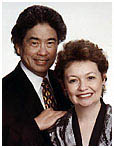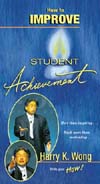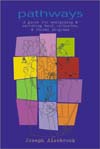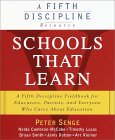|  Effective
Teaching...
Effective
Teaching...
by Harry and Rosemary
Wong
May
2005
Improving Student
Achievement Is Very Simple (Part 1)
The concept of school is very simple.
Teachers teach and students learn. Improve the teacher and you
improve the student.
Ask any CEO of a private company what is the greatest
asset of their company and they will tell you – their people.
When school administrators were asked,
what is the greatest asset in your schools?
1. Most administrators answered: money or finances
2. Others answered, their programs
3. A few said, the children or the students
Almost no one answered that their greatest asset is their teachers.
Yet, we all know that teacher quality is the most critical
factor by which to improve student achievement or close the achievement
gap.
- Teacher. It is the teacher, what the
teacher knows and can do, that is the most important factor
in improving student achievement.
- Instruction. It is how the teacher
instructs, not the program, the size of the school or classroom,
or the demographics of the students that determines student
learning.
Rather than invest in the comprehensive training of teachers,
many school districts invest in programs and structural changes.
Administrators. The school year may be coming to
a close, but it’s not too late to start planning for the
next school year.
What are you planning to do this summer: buy another curriculum
program, shuffle the school size, and reorganize job descriptions?
And when you review next year’s results, will student learning
be lacking again? We know why!
- Unsuccessful schools stress programs.
They spend millions of dollars adopting programs, fads of the
year, in constant pursuit of the quick fix on the white horse.
- Successful schools stress practices.
They wisely invest in their teachers and administrators and
their effectiveness. They don’t teach programs;
they teach basic, traditional academic content - and they work
at improving the instructional practices of their teachers.
So, stop spending millions of dollars adopting programs, philosophies,
and fads.
Student achievement has nothing to do with programs and class
or school size.
It’s the teacher – what
the teacher knows and what the teacher does in the classroom
-- that results in student learning.
That’s right. Improving student achievement is very
simple. It’s the teacher and how the teacher
instructs.
When teacher instruction is effective, you will see improved
student learning. In fact, the most effective teachers produce
as much as six times the learning gains as the least effective
teachers.
New Teachers Need More than a Mentor
Here’s some surprising news, but after some reflection
it does make sense.
A new teacher lowers achievement growth by
0.12-0.16 standard deviations.
Hanushek, Kain, O’Brien, & Rivkin (2005)
This is not a statement that is disrespectful of new
teachers. It’s just a fact of life that raw
rookies need training and help to become effective. New
baseball players are not inserted into a major league lineup right
after they sign a contract. Every single one of them is
sent to a minor league farm club to learn and hone their skills.
New employees in a law firm, a restaurant, or a hardware store
all start “from the bottom up” learning all the skills
of the profession and the practices of the company. In fact,
new employees all want to learn how they can fit into the company
and how they can add value to the company.
In theory, this is reasonable but it does not apply to teaching,
because new teachers are expected to take over a class on the
first day of school as all the other teachers do, and
they are expected to perform to the
same degree of proficiency as all the veteran teachers.
We know this, and it is an important but terrifying experience,
but when school starts again in about three months, many new teachers
will be, figuratively and literally, dumped into a classroom and
told to go and teach. Many of the new teachers who are hired
are not even shown to their classrooms or formally introduced
to the staff. The very person who is the most important
factor influencing student achievement begins in isolation and
continues the year in isolation.
Oh, but we give the new teacher a mentor, say many administrators.
As this article is being written, baseball season is
in full progress. Bill Carpenter, a recently retired
Connecticut elementary school principal, shares that when he graduated
from high school he was invited by the then Brooklyn Dodgers to
their spring training camp in Florida. At training camp,
he recalls, the camp was crawling with coaches. They had
coaches for pitching, batting, catching, base running, outfield
play, infield play, sliding, base stealing, taking signals, and
warming up drills, just to name a few.
There is no debating that one of baseball’s most valued
skills is batting, especially if you note the salaries of those
who can do it well. However, at a spring training camp,
they do not have every player participate exclusively in
batting practice.
Yet, that is exactly what many schools and school districts do,
and several states have mandated that a new teacher is given a
mentor. There is no question that a mentor is very important
to the success of a new teacher, just as good batting is important
to a baseball team’s success. But, mentoring
alone does not produce effective teachers.
All baseball teams have a comprehensive, organized spring training
program that continues during the playing season and even during
the off-season for those who want to continue their training.
They devote their time to all the components needed for a baseball
team to succeed.
It’s the same with schools:
- Some schools do nothing for their new teachers.
- Others just give the new teacher a mentor, and
- Others provide a comprehensive, coherent, and sustained professional
development program.
The research supports the latter as most successful.
Thomas Smith and Richard Ingersoll have determined the percentage
turnover of first year teachers. Very simply
- 41 percent of beginning teachers will leave after one year
if they receive no induction training
- 27 percent of beginning teachers will leave after one year
if they receive four components of induction training, and
- 18 percent of beginning teachers will leave after one year
if they receive seven components of induction training.
In other words, if all a new teacher receives is a mentor,
the new teacher has nearly a 40 percent chance of not making it
through one year of teaching.
That’s a tragic loss of human capital! And the loss
is not due to incompetence on the part of the teacher. It’s
due to the school or the district doing nothing to train and support
a new teacher.
Components of a Comprehensive Induction Program
It takes four to six years to develop an effective teacher.
Knowing this, effective induction programs are:
Comprehensive: The components include
many activities and people.
Coherent: The activities and people have
an organized purpose.
Sustained: The program continues for many
years, striving to develop effective teachers.
The components of an induction program could include the following:
- Begin with an initial four or five days of training (in classroom
management and effective teaching techniques) before school
begins.
- Offer a continuum of professional development through systematic
training over a period of two or three years.
- Provide study groups where new teachers can network and build
support, commitment, and leadership in a learning community.
- Incorporate a strong sense of administrative support.
- Integrate a mentoring component into the induction process.
- Present a structure for modeling effective teaching during
in-services and mentoring.
- Provide opportunities for inductees to visit demonstration
classrooms.
Good induction programs are very
structured and have a perfect blend of caring, accompanied
with a lot of supervision.
Mentoring Is Not Induction
The terms “induction” and “mentoring”
are often incorrectly used interchangeably to describe what happens
to a new teacher. It must be clarified that induction and
mentoring are not the same.
Induction is an organized, sustained, multiyear program structured
by a school or district, of which mentoring may be an integral
component. Induction is a group process, one that organizes
the expertise of educators within the shared values of a culture.
Mentoring is a one-on-one process, concerned with simply supporting
individual teachers, but mentoring is not a sustained process.
Most mentoring is done to help new
teachers survive, not to thrive.
We must stop trying to portray mentoring as the effective stand-alone
method for supporting and retaining teachers. Mentors are
important, but they are an isolated episode for one year or less
in a new teacher’s life. To be effective, mentors
need to be a component of the induction process.
The Difference between Mentoring and Induction
Mentoring
|
|
Induction
|
| Focuses on survival
and support |
|
Promotes career learning and professional development |
| |
|
|
| Relies on a single mentor or shares a mentor with other
teachers |
|
Provides multiple support people and administrative support |
| |
|
|
| Treats mentoring as an isolated event |
|
Comprehensive and
part of a lifelong professional
development design |
| |
|
|
| Limited resources spent |
|
Investment in an extensive,
comprehensive, and sustained induction program |
| |
|
|
| Reacts to whatever arises |
|
Acculturates a vision and aligns content to academic standards |
| |
|
|
Short-term, perhaps a year
|
|
Long-term, recurrent, sustained |
In many school districts,
- Mentoring is carried out one-on-one, in isolation, with no
coherence to any district/school curriculum, plan, goals, or
standards, nor is there any evaluation or rigorous monitoring
of the process, whereas
- Good induction programs are comprehensive, last several years,
have clearly articulated goals, provide a structured and nurturing
system of professional development and support, and are rigorously
monitored and evaluated.
Mentoring can’t do it all.
It should be obvious that adequate help cannot be done by another
teacher with a full-time load who drops by when time permits or
when a problem arises. Mentors may show up after school
begins and may not have been trained, compensated, or given direction
or goals to attain. Many mentors do not consult with other
mentors and may never even visit the mentee’s classroom.
We need more than mentors
to develop effective new teachers.
Mentoring is Not the Issue
The concept of mentoring began in 1980.
You know that year as the birth of the personal computer, most
notably the IBM PC with 16 kilobytes of memory. It’s
25 years later and we shake our heads at the thought of 16 kilobytes
(KB), because today’s computers commonly come with 1 gigabytes
of memory, which in round figures is one kilobyte times 1000 times
another 1000 equals one gigabyte of memory.
In 1996, Sharon Feiman-Nemser wrote an ERIC report on her critical
study of mentoring programs and said that few studies exist that
show the context, content, and consequences of mentoring.
And in 2004, Ingersoll and Kralik stated that the current research
did not provide definitive evidence of the value of mentoring
programs in keeping new teachers from leaving the profession.
These researchers are politely saying that there is no
research to support mentoring as an effective process to use to
train and produce effective teachers that will result in student
learning.
It is now 25 years later since mentoring came on the scene and
some people are still trying to sell it like someone would try
to sell an original IBM PC today.
And when you ask these good people how the mentoring process
is done, they will tell you that the mentor and the mentee get
together when the mentee needs help and they “reflect.”
Yes, they “reflect.”
The mentor may not have been trained, may not teach at the same
grade level or academic subject and the mentoring relationship
probably has no coherence or collaboration to
any state/district/school curriculum, plan, goals, or standards.
Also, the relationship lacks any structure, is not monitored,
and has no adequate follow-up procedure.
This should explain why we lose talented new teachers
every year.
Despite what has been said, the issue is not mentoring.
The issue is when mentoring is used as an isolated event.
Mentoring can be successful if mentors are a component part of
a comprehensive induction program.
It must be understood that mentoring is only one component of
a successful induction program. Without all of the components
in place, mentoring by itself will be of little benefit to new
teachers.
This is why such districts as
Prince Georges County in Maryland provides 35 hours of training
for each mentor, and Forsyth County in Georgia provides 100
hours of training for each mentor.
One purpose of this training is to align the mentoring
process with district goals that have as its main focus student
learning.
Susan Moore Johnson of the Project on the Next Generation of
Teachers at the Harvard Graduate School of Education says, “Mentoring
is all the rage. There is some sort of deep hope on the
part of everyone that if you get the right mentor, your life will
be saved and you will be the teacher you remember. But the
truth is that mentoring pairs seldom are anything but haphazard.
They are driven by the schedule. They are often not pairs
of people who really know the subjects that the individual is
teaching.”
Can you imagine a baseball team that does not have spring training?
Rather, they assign every new player a mentor and the new player
is told to contact their mentor if they need help. To make
matters worse, the mentor may not even play the same position,
which is what is often done to new teachers. That is, new
teachers don’t get help from someone in their field; they
get someone from “left field.”
In the sports world and the private sector, people are trained
continually. The goal is to achieve success. For those
who achieve exceptional success, they are inducted into the Baseball
Hall of Fame, the Marines, and a law firm.
You are not mentored into the Hall of Fame, the Marines, or a
law firm.
The concept of induction is used in every profession
except education. Doctors, lawyers, engineers,
and other professionals must all prove their abilities BEFORE
they are allowed to practice their professions independently.
They are not placed in professional settings and told to rely
on their mentors, which is what is commonly done in education.
For More information on Induction
New teachers learn best from systematic
induction programs.
The aforementioned Susan Moore Johnson at Harvard says, “Our
work suggests that schools would do better to rely less on one-to-one
mentoring and, instead, develop schoolwide structures that promote
integrated professional cultures with frequent exchange of information
and ideas across experience levels.”
And John Saphier, writing in Beyond Mentoring
says, “We need to provide a comprehensive induction program
that involves more than just mentors. Mentors alone, though
a critical part of good induction, cannot hope by themselves to
provide the range of input, feedback, and support beginning teachers
need. Well-designed induction programs include specific
roles for principals, superintendents, central office personnel,
the teachers’ union, parents, school board, and particularly
the other staff members where the beginning teacher works.”
This column will be continued next month, June.
For more information on new teacher induction, please
go to www.NewTeacher.com.
In particular, access
Apr. 8, 2005
“New Teacher Induction: The Foundation for Comprehensive,
Coherent, and Sustained Professional Development”
Feb 1, 2005
"Significant Research and Readings on Comprehensive Induction"
Jan 21, 2005
"What the World Can Teach Us About New Teacher Induction"
 For a printable version of this article click
here.
For a printable version of this article click
here.
Harry & Rosemary Wong products: http://www.harrywong.com/product/
Email Harry Wong: harrywong@teachers.net
Gazette Articles by Harry & Rosemary Wong:
If you spot a link that appears to be out-of-date, please alert us at webmaster@teachers.net!
- A Grateful Goodbye After 15 Years (Jun 2015)
- Love, Marriage, and Babies, Oh My! (May 2015)
- Retention Rate Is 100 Percent (Apr 2015)
- Teacher Effectiveness and Human Capital (Mar 2015)
- Training Teachers to Be Effective (Feb 2015)
- Making Deals Is Ineffective (Dec 2014 / Jan 2015)
- Retrieving and Carrying Electronic Devices (Nov 2014)
- Sharing to Succeed (Oct 2014)
- How a University Prepares Its Students (Sep 2014)
- Effective Teaching (Aug 2014)
- Your Future Is in Your Hands (June/July 2014)
- The Classroom Management Book (May 2014)
- When Students Succeed; Teachers Succeed (April 2014)
- Teaching New Teachers How to Succeed (March 2014)
- Execute and Praise (February 2014)
- Shaping a Solid Foundation (Dec 2013 / Jan 2014)
- The Most Misunderstood Word (November 2013)
- How to Start Class Every Day (October 2013)
- Prevention: The Key to Solving Discipline Problems (September 2013)
- Planning, Planning, Planning (August 2013)
- Are You THE One? (June / July 2013)
- Practical Examples That Work (May 2013)
- A Disability Is Not a Handicap (Apr 2013)
- Totally Inexcusable (Mar 2013)
- Be Proud of Public Education (Feb 2013)
- Structure Will Motivate Students (Dec 2012 / Jan2013)
- Orchestrating the Classroom (Nov 2012)
- The Lasting Impact of Instructional Coaching (Oct 2012)
- Learning, Laughing, and Leaving a Legacy (Sep 2012)
- Twenty-two, First Year, and Legit (Aug 2012)
- A Master Teacher of Teachers (June/July 2012)
- Where Going to School Means Success (May 2012)
- A Nationally Celebrated High School (Apr 2012)
- The Highest Rated School in New York City, Part 2 (Mar 2012)
- The Highest Rated School in New York City, Part 1 (Feb 2012)
- The Importance of Culture (Dec 2011 / Jan 2012)
- You Can Teach Classroom Management (Nov 2011)
- Seamless, Transparent, and Consistent (Oct 2011)
- Coaching Teachers to Be Effective Instructors (Sep 2011)
- How a Principal Creates a Culture of Consistency (Aug 2011)
- Graduation Begins in Your Classroom (June/July 2011)
- The Inspiration of a Mother (May 2011)
- How to Be an Effective Leader (Apr 2011)
- Learning Objectives: The Heart of Every Lesson (Mar 2011)
- Even Shakespeare Had Structure (Feb 2011)
- Effectiveness Defined: It's Not a Mystery (Dec 2010 / Jan 2011)
- Surviving Without a Principal (Nov 2010)
- Achieving Greatness: Locke Elementary School, Part 2 (Oct 2010)
- Teaching Greatness: Locke Elementary School, Part 1 (Sep 2010)
- Effective from the Start (Aug 2010)
- Ten Year Summary of Articles, 2000 to 2010 (June/July 2010)
- The Success of a Culture of Consistency (May 2010)
- Training Teachers to Be Effective (Apr 2010)
- Learning to Teach, Teaching to Learn (Mar 2010)
- Turning Teaching Dreams into Reality (Feb 2010)
- Dreams and Wishes Can Come True (Dec 2009 / Jan 2010)
- Success in a State Controlled School (Nov 2009)
- Inner City Is Not An Excuse (Oct 2009)
- Exceeding All Expectations (Sep 2009)
- Teachers Are the Difference (Aug 2009)
- Nine Year Summary of Articles, 2000 to 2009 (Jun/Jul 2009)
- Teachers Are the Greatest Assets (May 2009)
- The Tools for Success (Apr 2009)
- Assessing for Student Learning (Mar 2009)
- To Be an Effective Teacher Simply Copy and Paste (Feb 2009)
- The Sounds of Students Learning and Performing (Dec 2008)
- A School That Achieves Greatness (Nov 2008)
- Boaz City Schools: Professional Learning Teams (Oct 2008)
- It Was Something Close to a Miracle (Sep 2008)
- A Computer Teacher Shows the Way (Aug 2008)
- Eight Year Summary of Articles, 2000 to 2008 (Jun/Jul 2008)
- An Amazing Kindergarten Teacher (May 2008)
- Schools That Beat the Academic Odds (Apr 2008)
- Academic Coaching Produces More Effective Teachers (Mar 2008)
- Coaches Are More Effective than Mentors (Feb 2008)
- Wrapping the Year with Rap! (Dec 2007/Jan 2008)
- The Floating Teacher (Nov 2007)
- Taking the Bite Out of Assessment—Using Scoring Guides (Oct 2007)
- Ten Timely Tools for Success on the First Days of School (Sep 2007)
- First Day of School Script - in Spanish, Too! (Aug 2007)
- Seven Year Summary of Articles, 2000 to 2007 (Jun 2007)
- Effective Teachers End the Year Successfully (May 2007)
- Training Gen Y Teachers for Maximum Effectiveness (Apr 2007)
- Classroom Management Applies to All Teachers (Mar 2007)
- Students Want a Sense of Direction (Feb 2007)
- Rubrics in Two College Classes (Dec 2006/Jan 2007)
- How to Write a Rubric (Nov 2006)
- Assessing Student Progress with a Rubric (Oct 2006)
- A 92 Percent Homework Turn-in Rate (Sep 2006)
- Effective Teachers Are Proactive (Aug 2006)
- Five Year Summary of Articles (Jun 2006)
- Hitting the Bulls Eye as a Beginning Teacher (May 2006)
- They're Eager to Do the Assignments (Apr 2006)
- The Success of Special Ed Teachers (Mar 2006)
- What Teachers Have Accomplished (Feb 2006)
- Fifty Years Ago, The Legacy (Dec 2005/Jan 2006)
- The Emergency Teacher (Nov 2005)
- Classroom Management Is Not Discipline (Oct 2005)
- A Successful First Day Is No Secret (Sep 2005)
- The Most Important Factor (Aug 2005)
- Four Year Summary of Articles (Jul 2005)
- Improving Student Achievement Is Very Simple (Part 2) (Jun 2005)
- Improving Student Achievement Is Very Simple (Part 1) (May 2005)
- Never Cease to Learn (Apr 2005)
- His Classroom Is a Real Life Office (Mar 2005)
- The Power of Procedures (Feb 2005)
- The First Ten Days of School (Jan 2005)
- PowerPoint Procedures (Nov/Dec 2004)
- The Saints of Education (Oct 2004)
- How Procedures Saved a Teacher's Life (Sep 2004)
- How to Help Students with Their Assignments (Aug 2004)
- Three Year Summary of Articles (Jun/Jul 2004)
- His Students are All Certified (May 2004)
- What to Do When They Complain (Apr 2004)
- A Well-Oiled Learning Machine (Mar 2004)
- The Effective Teacher Adapts (Feb 2004)
- How to Start a Lesson Plan (Aug 2003)
- Applying for a Teaching Job in a Tight Market - Part 2 (Jun/Jul 2003)
- Applying for a Teaching Job in a Tight Market (May 2003)
- The Effective Substitute Teacher (Apr 2003)
- A First Day of School Script (Mar 2003)
- How to Retain New Teachers (Feb 2003)
- No Problem With Hurricane Lili (Dec 2002)
- A Class Size of 500 (Nov 2002)
- Effective Practices Apply to All Teachers (Oct 2002)
- Dispensing Materials in Fifteen Seconds (Sept 2002)
- How To Start School Successfully (Aug 2002)
- Teaching Procedures Is Teaching Expectations (June - July 2002)
- $50,000 to Replace Each Teacher (May 2002)
- Even Superintendents Do It (Apr 2002)
- Impossible, No Job Openings? (Mar 2002)
- A Stress Free Teacher (Feb 2002)
- A Most Effective School (Jan 2002)
- Van Gogh in Nine Hours (Dec 2001)
- The Effective Teacher Thinks (Nov 2001)
- How a Good University Can Help You (Sep 2001)
- How to Motivate Your Students (May 2001)
- How to Recognize Where You Want to Be (Apr 2001)
- What Successful New Teachers Are Taught (Mar 2001)
- A Journey of the Heart (Feb 2001)
- The Miracle of Teachers (Jan 2001)
- It's Not the Students. It's the Teacher. (Dec 2000)
- The First Five Minutes Are Critical (Nov 2000)
- How to Start a Class Effectively (Oct 2000)
- The Problem Is Not Discipline (Sep 2000)
- There Is Only One First Day of School (Aug 2000)
- Applying for Your First Job (Jul 2000)
- Your First Day (Jun 2000)
Browse through the latest posts from the Classroom Management
Chatboard...
|












 Effective
Teaching...
Effective
Teaching...